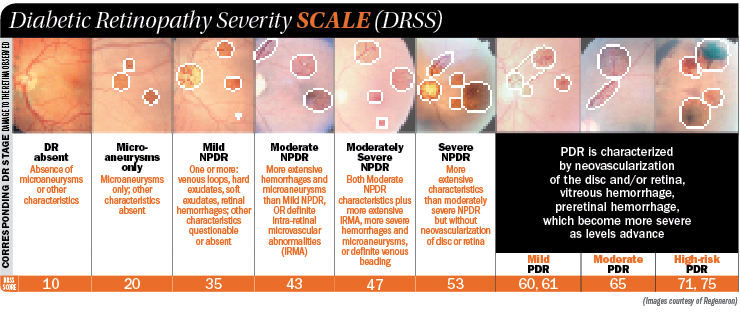Anti-VEGF expansion treats all DR stages

PANORAMA is the first prospective trial to study whether an anti-VEGF can also help prevent worsening disease in patients with NPDR without DME.
An expanded indication for aflibercept injection (Eylea, Regeneron) is now approved by the FDA to treat all stages of diabetic retinopathy (DR).
The approval is significant in that for the first time, an anti-vascular endothelial growth factor (VEGF) agent has been evaluated and approved in patients with moderately severe to severe non-proliferative diabetic retinopathy (NPDR).
“The PANORAMA trial marks the first time we have a prospective, multicenter, double-masked, randomized, controlled trial evaluating these high-risk NPDR eyes without diabetic macular edema (DME),” said Charles C. Wykoff, MD, PhD, Retina Consultants of Houston.
The study showed that not only can clinicians improve the Diabetic Retinopathy Severity Scale (DRSS) score, but they also can prevent sight-threatening complications, the development of PDR, and the development of center-involved DME, explained David Brown, MD, FACS, an investigator for the PANORAMA trial, and director of research, Retina Consultants of Houston.
In essence, physicians can turn an eye with 20 years’ of diabetic damage into one that only has 10 or 15 years of damage, Dr. Brown added.
“That gives patients another 10 or 15 years to take better care of themselves, improve blood sugars, and improve cholesterol levels,” he said. “Most patients are in denial until they get an end-organ problem like kidney failure, DR, or nephropathy. We now can help mediate some of that end-organ damage.”
For the treatment of DR, aflibercept may be dosed every 8 weeks following five initial monthly injections, or every 4 weeks.
WHAT PANORAMA FOUND
The FDA approval was based on 6-month and 1-year results from PANORAMA, a randomized, multicenter, controlled phase III trial that enrolled 402 patients and was designed to investigate the improvement of moderately severe to severe NPDR without DME, compared to sham injection.
PANORAMA is the first prospective trial to study whether an anti-VEGF can also help prevent worsening disease in patients with NPDR without DME.
“All of our previous DR analyses come from eyes with proliferative diabetic retinopathy or NPDR with DME,” Dr. Wykoff said. “This the first time we have NPDR without DME. It’s an important landmark trial for that key reason.”
An ongoing issue for physicians is that with proliferative disease, “the downside is too high for most doctors and patients for noncompliance,” Dr. Brown said, noting most patients have been noncompliant for decades with other aspects of their diabetes control.
“To me, it’s a much easier argument to treat NPDR, because what would I have done for them otherwise? Nothing,” Dr. Brown said.
With the option to dose every 4 or 8 weeks and individualize therapy, Dr. Wykoff noted it is “good to be able to have more frequent dosing on-label.”
The PANORAMA trial evaluated a q16 arm as well and those patients did well, he added.
“They did equally well to the q8 arm through 6 and through 12 months,” Dr. Wykoff said. “Both arms were highly statistically significantly better than sham. In the real world, monthly and even every-other-month dosing is impractical for many patients, and the q16 arm speaks to that.”
The safety outcomes in PANORAMA were similar to what was found in the pivotal phase III studies on aflibercept for DME.
Though there was improvement in visual acuity scores, these were not statistically different between the two aflibercept arms, and neither of the groups improved by more than 1.5 letters.
Clinical signs of high-risk NPDR, such as intraretinal microvascular abnormalities and venous bleeding, indicate Level 53 on the DRSS scoring-and about 40% of these patients will develop proliferative disease within a year, Dr. Brown said.
With the new approval, however, “we’re going to be treating patients before they get into trouble as opposed to waiting until the plane’s nose-diving and you’re dumping fuel,” he said.
“Even if you treat with just the loading dose, we’ll be able to knock them down to the low-level 53 and out of high-risk NPDR and a moderate or mild NPDR in almost all of them,” Dr. Brown said. “Those are the patients that make the most sense to treat.”
Dr. Wykoff said that anatomically, there is strong evidence that anti-VEGF therapy provides “dramatic benefit, both through improving DR severity levels and decreasing the development of PDR and center-involved DME.
“Through 1 year, we have seen that the hemorrhages get better and that fewer eyes develop PDR and DME, but we have not yet seen functional data,” he noted. “That is, does earlier treatment, before eyes develop PDR or DME, result in better long-term functional outcomes or a decrease in treatment burden? Such data would be valuable.”
The q16 arm pushed the envelope to see how much dosing frequency was necessary to maintain DR severity improvements, and the hope is “less-frequent dosing will allow improved compliance,” Dr. Wykoff said.
Since it remains unknown how often clinicians ideally should be treating patients, the data set from PANORAMA is likely to be a starting point.
“Fortunately, PANORAMA is a 2-year trial, and visual field is one of the endpoints. I look forward to collecting more functional endpoints evaluating the value of earlier intervention,” said Dr. Wykoff, who added the Diabetic Retinopathy Clinical Trial Retina Network is also evaluating anatomic and functional endpoints in the ongoing Protocol W.
Including this expanded approval, aflibercept is indicated for the treatment of wet age-related macular degeneration (AMD), macular edema following retinal vein occlusion (RVO), DME, and DR.
Disclosures:
David Brown, MD, FACS
E: dmbmd@houstonretina.com
Charles C. Wykoff, MD, PhD
E: ccwmd@houstonretina.com
Both Drs. Brown and Wykoff are consultants and researchers for Regeneron.
Newsletter
Keep your retina practice on the forefront—subscribe for expert analysis and emerging trends in retinal disease management.